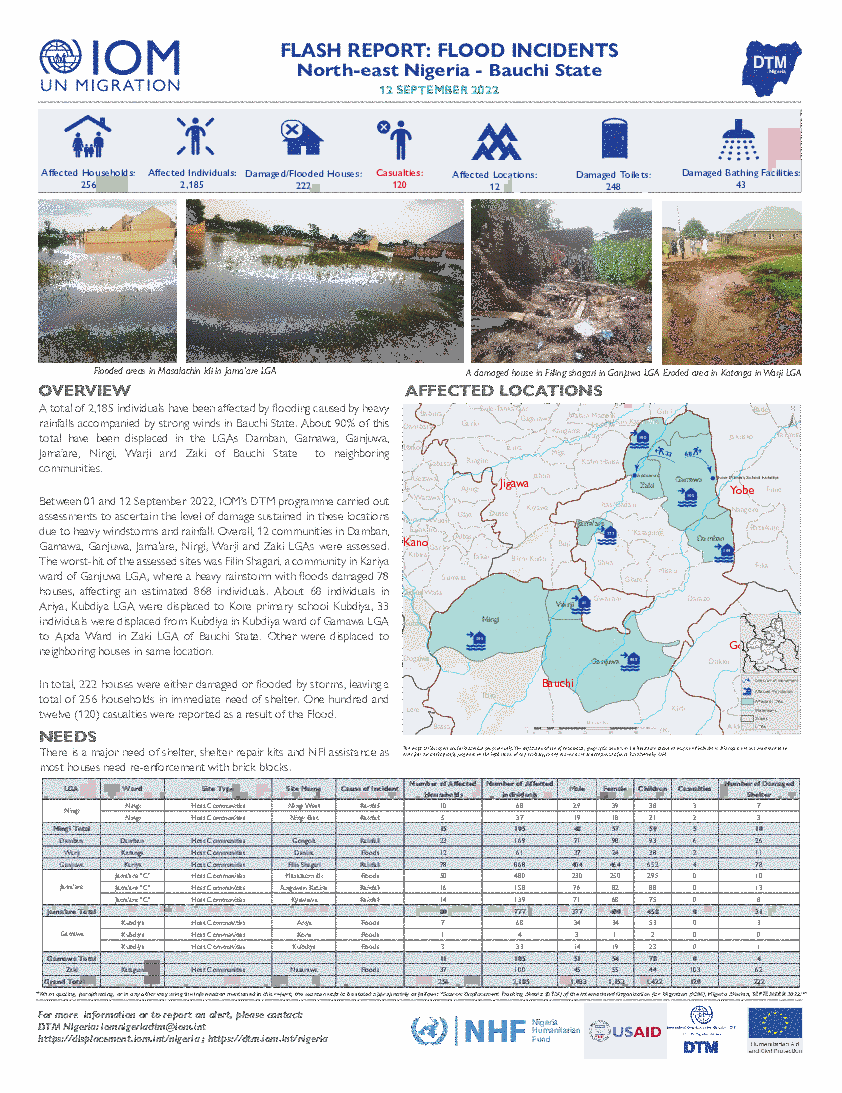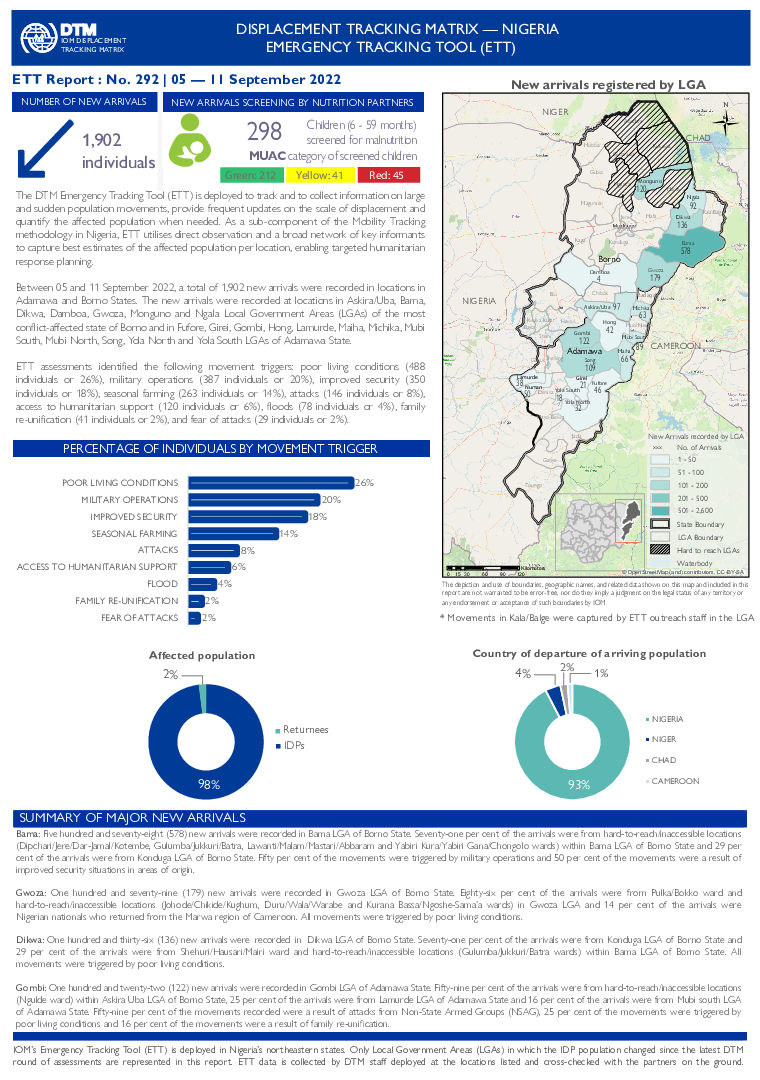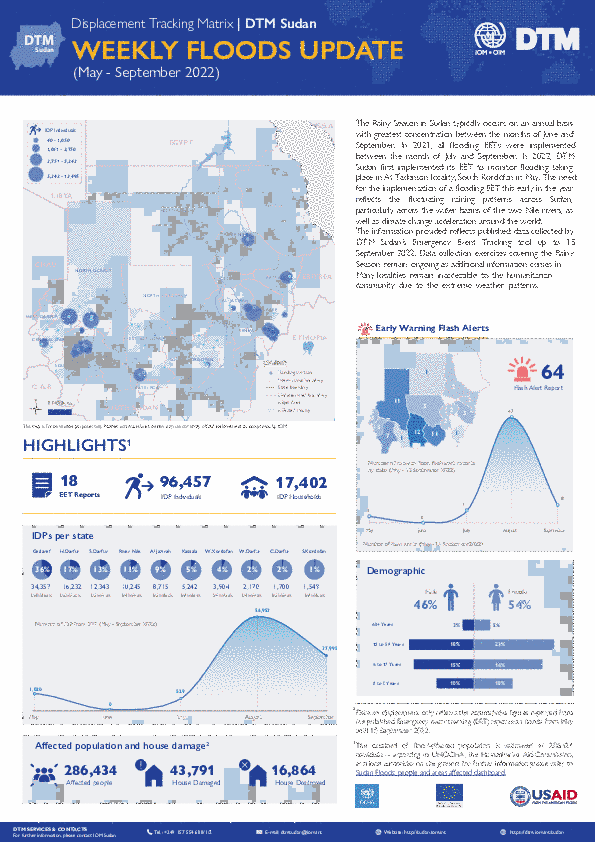-
Countries
-
Data and Analysis
-
Special Focus
-
Crisis Responses

Contact
DTM Mali, DTMMali@iom.int
Language
French
Location
Mali
Period Covered
Aug 01 2022
Aug 31 2022
Activity
- Flow Monitoring
Afin de mieux comprendre les mouvements et tendances migratoires, l’OIM, à travers la Matrice de suivi des déplacements (Displacement Tracking Matrix, DTM), met en œuvre l’activité de Suivi des flux de populations (Flow Monitoring, FM).
Le suivi des flux, qui est mis en œuvre en étroite collaboration avec les autorités et des partenaires nationaux et locaux, est composé de deux outils: l’enregistrement des flux (Flow Monitoring Registry, FMR), qui recueille des données clés sur l’ampleur, la provenance, la destination et les modalités des flux de mobilité, et les enquêtes individuelles (Flow Monitoring Survey, FMS), conduites auprès des voyageurs afin d’obtenir des informations sur les profils, parcours migratoires, et intentions des migrants. Le suivi des flux de populations récolte ainsi des données sur les flux et tendances migratoires, les profils des voyageurs et les parcours et intentions des migrants, afin de fournir une meilleure compréhension des mobilités.
Au Mali, la DTM recueille des données au niveau de 7 Points de suivi des flux (Flow Monitoring Points, FMP), répartis dans 6 régions afin d’obtenir une meilleure compréhension de l’ampleur, des tendances, des caractéristiques socio-démographiques et des parcours des flux de voyageurs traversant ces différents points.
Ce rapport présente les données recueillies dans le cadre des activités d’enregistrement des flux durant le mois de août 2022.

Contact
DTM Nigeria, AllUsersInDTMNigeria@iom.int
Language
English
Location
Nigeria
Period Covered
Sep 01 2022
Sep 12 2022
Activity
- Mobility Tracking
- Event Tracking
A total of 2,185 individuals have been affected by flooding caused by heavy rainfalls accompanied by strong winds in Bauchi State. About 90% of this total have been displaced in the LGAs Damban, Gamawa, Ganjuwa, Jama’are, Ningi, Warji and Zaki of Bauchi State to neighboring communities.
Between 01 and 12 September 2022, IOM’s DTM programme carried out assessments to ascertain the level of damage sustained in these locations due to heavy windstorms and rainfall. Overall, 12 communities in Damban, Gamawa, Ganjuwa, Jama’are, Ningi, Warji and Zaki LGAs were assessed. The worst-hit of the assessed sites was Filin Shagari, a community in Kariya ward of Ganjuwa LGA, where a heavy rainstorm with floods damaged 78 houses, affecting an estimated 868 individuals. About 68 individuals in Ariya, Kubdiya LGA were displaced to Kore primary school Kubdiya, 33 individuals were displaced from Kubdiya in Kubdiya ward of Gamawa LGA to Apda Ward in Zaki LGA of Bauchi State. Other were displaced to neighboring houses in same location.
In total, 222 houses were either damaged or flooded by storms, leaving a total of 256 households in immediate need of shelter. One hundred and twelve (120) casualties were reported as a result of the Flood.

Contact
DTMLACsupport@iom.int
Language
French
Location
Niger
Period Covered
Jan 01 2022
Mar 31 2022
Activity
- Survey
- Flow Monitoring
Afin de mieux comprendre les mouvements et les tendances migratoires en Afrique de l’Ouest et du Centre, l’Organisation internationale pour les migrations (OIM), à travers la Matrice de suivi des déplacements (Displacement Tracking Matrix (DTM) en anglais), met en œuvre l’activité de Suivi des flux de populations (Flow Monitoring (FM) en anglais).
Le suivi des flux, qui est mis en œuvre en étroite collaboration avec les autorités et des partenaires nationaux et locaux, est composé de deux outils : l’enregistrement des flux (Flow Monitoring Registry (FMR) en anglais), qui recueille des données clés sur l’ampleur, la provenance, la destination et les modalités des flux de mobilité. À cela s’ajoute, les enquêtes individuelles (Flow Monitoring Survey (FMS) en anglais), conduites auprès des voyageurs afin d’obtenir des informations sur les profils, les parcours migratoires, et les intentions des migrants. Le suivi des flux de populations récolte ainsi des données sur les flux et les tendances migratoires, les profils des voyageurs, les parcours et les intentions des migrants, afin de fournir une meilleure compréhension des mobilités en Afrique de l’Ouest et du Centre.
Au Niger, la DTM recueille des données à sept points de suivi des flux (Flow Monitoring Point (FMP) en anglais), dans le but d’identifier les zones à forte mobilité transfrontalière et intra régionale, et récolter des données sur les tendances de mobilités, les profils et les parcours des voyageurs dans le pays.
Ce rapport présente les données obtenues au travers des activités FMR et FMS de janvier à mars 2022, au niveau des sept FMP installés au Niger.
Pour plus d’information sur la méthodologie du suivi des flux, merci de consulter la dernière page de ce rapport.

Contact
DTM Nigeria, AllUsersInDTMNigeria@iom.int
Language
English
Location
Nigeria
Period Covered
Sep 05 2022
Sep 11 2022
Activity
- Mobility Tracking
- Event Tracking
The DTM Emergency Tracking Tool (ETT) is deployed to track and to collect information on large and sudden population movements, provide frequent updates on the scale of displacement and quantify the affected population when needed. As a sub-component of the Mobility Tracking methodology in Nigeria, ETT utilises direct observation and a broad network of key informants to capture best estimates of the affected population per location, enabling targeted humanitarian response planning.
Between 05 and 11 September 2022, a total of 1,902 new arrivals were recorded in locations in Adamawa and Borno States. The new arrivals were recorded at locations in Askira/Uba, Bama, Dikwa, Damboa, Gwoza, Monguno and Ngala Local Government Areas (LGAs) of the most conflict-affected state of Borno and in Fufore, Girei, Gombi, Hong, Lamurde, Maiha, Michika, Mubi South, Mubi North, Song, Yola North and Yola South LGAs of Adamawa State.
ETT assessments identified the following movement triggers: poor living conditions (488 individuals or 26%), military operations (387 individuals or 20%), improved security (350 individuals or 18%), seasonal farming (263 individuals or 14%), attacks (146 individuals or 8%), access to humanitarian support (120 individuals or 6%), floods (78 individuals or 4%), family re-unification (41 individuals or 2%), and fear of attacks (29 individuals or 2%).

Contact
dtmsudan@iom.int
Language
English
Location
Sudan
Period Covered
Jan 01 2022
Sep 15 2022
Activity
- Event Tracking
The Rainy Season in Sudan typically occurs on an annual basis with greatest concentration between the months of June and September. In 2021, all flooding EETs were implemented between the month of July and September. In 2022, DTM Sudan first implemented its EET to monitor flooding taking place in At Tadamon locality, South Kordofan in May. The need for the implementation of a flooding EET this early in the year reflects the fluctuating raining patterns across Sudan, particularly across the water basins of the two Nile rivers.
The information provided reflects published data collected by DTM Sudan’s Emergency Event Tracking tool up to 8 September 2022. Data collection exercises covering the Rainy Season remain ongoing, with displacement data expected to increase dramatically as additional information comes in. Many localities remain inaccessible to the humanitarian community due to the extreme weather patterns. Data is expected to continue coming in from South Darfur state.
La région du Sahel central, et plus particulièrement la zone du Liptako Gourma, qui enjambe le Burkina Faso, le Mali et le Niger, est témoin d’une crise complexe qui comprend comme enjeux une compétition grandissante pour le contrôle de ressources; des bouleversements climatiques; une croissance démographique galopante; des niveaux élevés de pauvreté; l’absence d’opportunités économiques et un sentiment de désillusions quant au futur; des tensions communautaires; l’absence de présence étatique et le manque de services sociaux de base; et des violences provoquées par des réseaux de crime organisé et des groups armés non étatiques. La crise a engendré, en 2021, la mort de 5 000 personnes (au 31 décembre) et conduit à des déplacements de populations significatifs dans les quatre pays touches par la crise.
Au 22 août 2022, 2 672 415 individus étaient déplacés par la crise, y compris 2 463 710 Personnes déplacées internes (92% de la population affectée) et 208 705 réfugiés (8%). Soixante-douze pour cent de la population déplacée (1 928 759 personnes) se trouvait au Burkina Faso, 16 pour cent au Mali (434 849), 8 pour cent au Niger (223 724) et 3 pourcent en Mauritanie (85 083).
The Central Sahel area, and in particular the Liptako Gourma region, which borders Burkina Faso, Mali and Niger, is affected by a complex crisis involving growing competition over dwindling resources; climatic variability; demographic pressure; high levels of poverty; disaffection and a lack of livelihood opportunities; communal tensions; the absence of state institutions and basic services; and violence related to organized crime and Non-State Armed Groups. The crisis has led to the death of an estimated 5,000 people in 2021 (as of 31 December) and triggered significant displacement of populations in the four affected countries.
As of 22 August 2022, 2,672,415 individuals have been displaced, including 2,463,710 Internally Displaced Persons (92% of the displaced population) and 208,705 Refugees (8% of the displaced population). Seventy-two per cent of the displaced population (1,928,759 individuals) were located in Burkina Faso, while 16 per cent resided in Mali (434,849 individuals), 8 per cent in Niger (223,724 individuals) and 3 per cent in Mauritania (85,083 individuals).
The crisis currently affecting the Lake Chad Basin states results from a complex combination of factors, including conflict with Non-State Armed Groups, extreme poverty, underdevelopment and a changing climate, which together have triggered significant displacement of populations. As of 22 August 2022, Cameroon, Chad, Niger and Nigeria were hosting an estimated 5,595,058 affected individuals made up of Internally Displaced Persons (IDPs), Refugees (both in- and out-of-camp), Returnees (Former IDPs and Returnees from abroad) and Third Country Nationals (TCNs). 75 per cent of the affected population (representing 4,180,954 individuals) were located in Nigeria, while 11 per cent resided in Cameroon (639,453 individuals), 9 per cent in Chad (488,510 individuals) and 5 per cent in Niger (286,141 individuals).
La crise dans le Bassin du lac Tchad est le résultat d’une combinaison complexe d’une multitude de facteurs, y compris un conflit armé impliquant des groups armés non étatiques, des niveaux extrêmes de pauvreté, un sous-développement persistent, et des bouleversements climatiques, qui ont conduit à des déplacements de populations importants. Au 22 août 2022, le Cameroun, le Tchad, le Nigeria et le Niger accueillaient 5 595 058 individus affectés par la crise, dont des Personnes déplacées internes (PDI), des réfugiés et des retournés (anciennes PDI et retournés de l’étranger). 75 pour cent d’entre eux (soit 4 180 954 personnes) se trouvaient au Nigéria, 11 pour cent au Cameroun (639 453 personnes), 9 pour cent au Tchad (488 510 personnes) et 5 pour cent au Niger (286 141 personnes).
The Central African Republic, which has experienced continuous volatility for the past two decades, has been riddled by a crisis which ignited in 2012 with a violent takeover of power and has developed into a complex protracted state of permanent insecurity and fragility which has spilled over into neighbouring countries. The crisis has led to the death of an estimated 506 people in 2022 (as of 30 April) and triggered significant displacement of populations in the seven affected countries. The crisis is characterized by power struggles amongst elites, the absence of state institutions and public investment, religious and ethnic tensions and disputes for the control of key resources.
As of 22 August 2022, 3,348,371 individuals were displaced, including 647,883 Internally Displaced Persons (19% of the displaced population), 1,588,289 Returnees (former IDPs) (47%), 377,297 Returnees from abroad (11%) and 734,902 Refugees in neighbouring countries (22%). In the Central African Republic, the largest displaced population consists of Former IDP Returnees (62%), while IDPs represent 24 per cent of the displaced population present in the country and Returnees from abroad represent 14 per cent of in-country displaced people. Refugees from the Central African Republic are primarily hosted by Cameroon (347,575 individuals, or 47% of refugees), the Democratic Republic of the Congo (206,967 individuals, or 28% of refugees) and Chad (124,488 individuals, or 17% of refugees).




